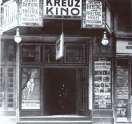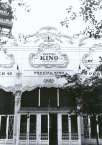 Already
three months after the first public film presentation in Paris, in the
1st district of Vienna silent pictures flickered over a screen, accompanied
by live piano music. Of course these shows were a sensation and even emperor
Franz Josef I came to see a performance.
Already
three months after the first public film presentation in Paris, in the
1st district of Vienna silent pictures flickered over a screen, accompanied
by live piano music. Of course these shows were a sensation and even emperor
Franz Josef I came to see a performance.
| Year |
|
|
| 1949* 1950 1951 1952 1953 1954 1955 1956 1957 1958 1959 1960 1961 1962 1963 1964 1965 1966 1967 1968 1969 1970 1971 1972 1973 1974 1975 1976 1977 1978 1979 1980 1981 1982 1983 1984 1985 1986 1987 1988 1989 1990 1991 1992 1993 1994 |
|
|
| * Source: Fachverband der Lichtspieltheater, Austria | ||
In 1913 the Reichsverband der Lichtspieltheater (State Organisation of Cinemas) arranged the first conditions for film distribution with the pioneers. Two years later this branch grew spectacularly.
In 1916 the first Kinospiegel (film criticism) was published in a daily newspaper. At the same time the first regulations concerning the protection of children and young people in connection with cinema visits were published.
 At
the beginning of the 'golden era of silent film' the full length feature
film was already a success; a visit to the cinema was an artistic treat
as well as entertainment, it meant close attention and adventure at the
same time. The climax of the silent film era, however, already showed signs
of decay. As early as 1928 Sonny Boy, featuring the American Al
Jolson, was screened in the Schweden Kino, located in Vienna's Taborstraße.
By 1932 exclusively sound films were projected in the Austrian cinemas.
At
the beginning of the 'golden era of silent film' the full length feature
film was already a success; a visit to the cinema was an artistic treat
as well as entertainment, it meant close attention and adventure at the
same time. The climax of the silent film era, however, already showed signs
of decay. As early as 1928 Sonny Boy, featuring the American Al
Jolson, was screened in the Schweden Kino, located in Vienna's Taborstraße.
By 1932 exclusively sound films were projected in the Austrian cinemas.
In 1931 the first newsreel was screened in Austria and up until the Fifties this type of film gained in importance by informing the public about news topics from all over the world, in an audiovisual way. During these years the exhibitors had to pay film rental of 28% of box office receipts.
 After
the Second World War, from 1945 on, things were going well again for the
cinema. New cinemas opened, for instance in Vienna: the large Forum cinema
(1950) and the remarkable Metro (1951), the latter being a former theatre.
In 1950 the professional associations of distributors and exhibitors agreed
on general conditions concerning film supply, which, in structure, are
still effective today. In 1958 Austria met the climax of the cinema boom:
there were 1 244 cinemas throughout the country (one cinema for every 5
600 inhabitants!). Not less than 122 million people visited the cinemas,
which brought the average of cinema attendance per head of population to
17 for this top year.
After
the Second World War, from 1945 on, things were going well again for the
cinema. New cinemas opened, for instance in Vienna: the large Forum cinema
(1950) and the remarkable Metro (1951), the latter being a former theatre.
In 1950 the professional associations of distributors and exhibitors agreed
on general conditions concerning film supply, which, in structure, are
still effective today. In 1958 Austria met the climax of the cinema boom:
there were 1 244 cinemas throughout the country (one cinema for every 5
600 inhabitants!). Not less than 122 million people visited the cinemas,
which brought the average of cinema attendance per head of population to
17 for this top year.
 There
were symptoms of a crisis noticeable in the development, mainly caused
by the invention and spread of television and changing leisure activities.
Mobility also changed, caused by increasing car ownership and general prosperity.
Long distance travel, sports, weekend trips and short holidays infiltrated
the previously unique status of the cinema. In 1955 there were only 1 420
television sets in Austria, but between 1960 and 1977 more than 700 cinemas
had to be closed. In 1974 there were 645 cinemas left, whereas in 1994
there were less than 390. In 20 years, attendances decreased from 23 to
13 million.
There
were symptoms of a crisis noticeable in the development, mainly caused
by the invention and spread of television and changing leisure activities.
Mobility also changed, caused by increasing car ownership and general prosperity.
Long distance travel, sports, weekend trips and short holidays infiltrated
the previously unique status of the cinema. In 1955 there were only 1 420
television sets in Austria, but between 1960 and 1977 more than 700 cinemas
had to be closed. In 1974 there were 645 cinemas left, whereas in 1994
there were less than 390. In 20 years, attendances decreased from 23 to
13 million.
When Austria's first cinema centre opened in 1979, a new era had come
into being. Although the former number of visitors could no longer be hoped
for and audiences were decreasing, there still was hope from the qualitative
point of view. During the eighties the cinema became, together with the
introduction of VCR, cable and satellite TV, a medium of active people,
conscious of their leisure-time. Only since 1992 has there been a visible
positive trend in cinema attendance. From 1992 to 1993 the number of visitors
increased by 29% and from 1993 to 1994 by 8%; the number of visitors of
cinemas went up again to 13 million. The cinema is in fashion once again,
as was predicted by researchers. This development has started just in time
to initiate the next '100 years of cinema'.
 Già
tre mesi dopo la prima proiezione pubblica a Parigi, nel primo distretto
di Vienna vennero presentati su schermo alcuni film muti, accompagnati
dalla musica di un pianoforte. Questi spettacoli erano talmente sensazionali
che anche l'imperatore Francesco Giuseppe assistette ad una rappresentazione.
Già
tre mesi dopo la prima proiezione pubblica a Parigi, nel primo distretto
di Vienna vennero presentati su schermo alcuni film muti, accompagnati
dalla musica di un pianoforte. Questi spettacoli erano talmente sensazionali
che anche l'imperatore Francesco Giuseppe assistette ad una rappresentazione.
| Anno |
|
|
| 1949* 1950 1951 1952 1953 1954 1955 1956 1957 1958 1959 1960 1961 1962 1963 1964 1965 1966 1967 1968 1969 1970 1971 1972 1973 1974 1975 1976 1977 1978 1979 1980 1981 1982 1983 1984 1985 1986 1987 1988 1989 1990 1991 1992 1993 1994 |
|
|
| * Fonte: Fachverband der Lichtspieltheater, Austria | ||
Nel 1913 il Reichsverband der Lichtspieltheater (Organizzazione Statale del Cinema) definì le prime condizioni per la distribuzione cinematografica. Due anni dopo questo ramo si sviluppò incredibilmente. Nel 1916 il primo Kinospiegel (critica cinematografica) fu pubblicato in un quotidiano. Nel contempo furono emesse le prime regolamentazioni riguardanti la protezione dei bambini e dei giovani in relazione alla proiezione cinematografica.
 All'inizio
dell'"era d'oro del cinema muto", il primo lungometraggio risultò
essere già un successo; andare al cinema era un piacere artistico
oltre che una forma di intrattenimento, il che significava attenzione ed
emozione allo stesso tempo. Pur nel momento dell'apice il cinema muto mostrava
già segni di decadenza. Già nel 1928, Sunnyboy, il cui protagonista
era l'americano Al Jolson, fu proiettato allo Schweden Kino, situato nella
Taborstraße a Vienna. Nel 1932, erano ormai proiettati, nelle sale
austriache, esclusivamente film sonori.
All'inizio
dell'"era d'oro del cinema muto", il primo lungometraggio risultò
essere già un successo; andare al cinema era un piacere artistico
oltre che una forma di intrattenimento, il che significava attenzione ed
emozione allo stesso tempo. Pur nel momento dell'apice il cinema muto mostrava
già segni di decadenza. Già nel 1928, Sunnyboy, il cui protagonista
era l'americano Al Jolson, fu proiettato allo Schweden Kino, situato nella
Taborstraße a Vienna. Nel 1932, erano ormai proiettati, nelle sale
austriache, esclusivamente film sonori.
Nel 1931 venne proiettato in Austria il primo cinegiornale e, fino agli anni Cinquanta, questo genere di filmato acquistò sempre più importanza, informando il pubblico, attraverso le tecniche audiovisive, con notizie riguardanti il mondo intero.
Durante quegli anni, il canone di noleggio per gli esercenti era pari al 28% degli incassi.
 Dopo
la Seconda Guerra Mondiale, dal 1945 in poi, la situazione tornò
ad essere favorevole per le sale. Vennero aperte nuove sale cinematografiche,
per esempio a Vienna: il grande cinema Forum (1950) e il famoso Metro (1951),
che in precedenza era stato un teatro. Nel 1950 le associazioni professionali
dei distributori e degli esercenti concordarono alcune condizioni generali
per il noleggio dei film, che, in termini di principio, sono tuttora in
uso. Nel 1958 l'Austria visse il boom del cinema: esistevano allora 1 244
sale cinematografiche distribuite su tutto il territorio (una sala ogni
5 600 abitanti!). Non meno di 122 milioni di persone frequentarono i cinema,
il che significò una frequenza media pro capite pari a 17.
Dopo
la Seconda Guerra Mondiale, dal 1945 in poi, la situazione tornò
ad essere favorevole per le sale. Vennero aperte nuove sale cinematografiche,
per esempio a Vienna: il grande cinema Forum (1950) e il famoso Metro (1951),
che in precedenza era stato un teatro. Nel 1950 le associazioni professionali
dei distributori e degli esercenti concordarono alcune condizioni generali
per il noleggio dei film, che, in termini di principio, sono tuttora in
uso. Nel 1958 l'Austria visse il boom del cinema: esistevano allora 1 244
sale cinematografiche distribuite su tutto il territorio (una sala ogni
5 600 abitanti!). Non meno di 122 milioni di persone frequentarono i cinema,
il che significò una frequenza media pro capite pari a 17.
 Si
avvertivano però già i sintomi della crisi, causata soprattutto
dall'invenzione e dalla diffusione della televisione e dal cambiamento
del tipo delle attività del tempo libero. Variò anche la
mobilità a causa della crescente diffusione delle auto e dell'aumento
delle condizioni di benessere. I viaggi a lunga distanza, le attività
sportive, le escursioni del fine settimana e le brevi vacanze intaccarono
la precedente caratteristica di unicità del cinema. Nel 1955 si
contavano solo 1 420 apparecchi televisivi in Austria, ma tra il 1960 ed
il 1977 più di 700 sale cinematografiche dovettero essere chiuse.
Nel 1974 erano rimaste solo 645 sale cinematografiche e nel 1994 ne esistevano
meno di 390. Nel giro di vent'anni, la frequenza diminuì da 23 a
13 milioni.
Si
avvertivano però già i sintomi della crisi, causata soprattutto
dall'invenzione e dalla diffusione della televisione e dal cambiamento
del tipo delle attività del tempo libero. Variò anche la
mobilità a causa della crescente diffusione delle auto e dell'aumento
delle condizioni di benessere. I viaggi a lunga distanza, le attività
sportive, le escursioni del fine settimana e le brevi vacanze intaccarono
la precedente caratteristica di unicità del cinema. Nel 1955 si
contavano solo 1 420 apparecchi televisivi in Austria, ma tra il 1960 ed
il 1977 più di 700 sale cinematografiche dovettero essere chiuse.
Nel 1974 erano rimaste solo 645 sale cinematografiche e nel 1994 ne esistevano
meno di 390. Nel giro di vent'anni, la frequenza diminuì da 23 a
13 milioni.
Quando, nel 1979, venne aperto in
Austria il primo complesso cinematografico, cominciò una nuova era.
Sebbene non si potesse più sperare nel livello precedente di spettatori
e sebbene il pubblico fosse diminuito, emergeva comunque una speranza dal
punto di vista qualitativo. Durante gli anni Ottanta il cinema, insieme
all'introduzione del videoregistratore, TV via cavo e via satellite, divenne
un consumo per gente attiva, attenta all'impiego del proprio tempo libero.
Solo a partire dal 1992 si è consolidata una tendenza positiva nella
frequenza cinematografica. Dal 1992 al 1993 il numero di spettatori è
aumentato del 29% e dal 1993 al 1994 dell'8%: il numero degli spettatori
nelle sale cinematografiche ha toccato nuovamente la soglia dei 13 milioni.
Il cinema è ancora una volta di moda, come previsto dalle ricerche.
Questo sviluppo ha avuto luogo giusto in tempo per l'inizio del prossimo
"secolo del cinema".